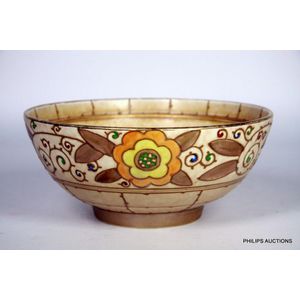Famille Rose Bowl with Female Figures and Courtyard Settings
You must be a subscriber, and be logged in to view price and dealer details.
Subscribe Now to view actual auction price for this item
When you subscribe, you have the option of setting the currency in which to display prices to $Au, $US, $NZ or Stg.
- Gilding - Gilding is a method of ornamentation whereby a thin sheet of gold metal is applied to items made of wood, leather, ceramics, glass and silver for decorative purposes.
For furniture including mirrors, the sheet of gold is usually applied over a coating of gesso. Gesso is a mixture of plaster of Paris and gypsum mixed with water and then applied to the carved wooden frames of mirrors and picture frames as a base for applying the gold leaf. After numerous coats of gesso have been applied, allowed to dry and then sanded a coat of "bole", a usually red coloured mixture of clay and glue is brushed on and allowed to dry, after which the gold leaf is applied. Over time parts of the gilding will rub off so the base colour can be seen. In water gilding, this was generally a blue colour, while in oil gilding, the under layer was often yellow. In Victorian times, gilders frequently used red as a pigment beneath the gold leaf.
Metal was often gilded by a process known as fire gilding. Gold mixed with mercury was applied and heated, causing the mercury to evaporate, the long-term effect of which was to kill or disable the craftsman or woman from mercury poisoning. The pursuit of beauty has claimed many victims, not the least of which were the artists who made those pieces so highly sought after today.
This item has been included into following indexes:
Visually similar items

An 18th/19th century Chinese export ware porcelain small punch bowl, famille rose decoration of figures in landscapes, old staple repaired cracks. diameter 26 cm.

An H.J wood Bursley-Ware bowl by Charlotte Rhead, circa 1935, pattern TL3, Tubelined and decorated in a typical autumnal and lustre palette upon a mottled beige ground with a trellis design to the lower body with bold flower heads and tendrils; backstamp o

A fine Chinese porcelain bowl, with famille rose decoration to the exterior and blue and white decoration to the interior; the exterior decorated with four circular 'windows' each showing seasonal fruits and flowers, all framed by stylised flowers and bat

Chinese late Qing Dynasty porcelain bowl, of handsome proportions, decorated with birds amongst flowering trees, in tones of green, yellow and red, a/f, diameter 29 cm
